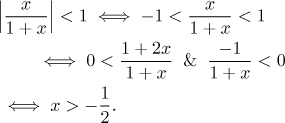
Problem: Investigate convergence of the following series of functions:

Solution: First we investigate pointwise convergence. We treat x as a parameter and test convergence of the resulting series of real numbers. In a typical case we would test absolute convergence using some tests, we show this approach in this note. However, this approach, while more general, yields less information, in particular it does not tell us what a sum of a series is. Usually we accept this limitation and go to tests right away, why not here?
If they did not expect us to do something with the sum of this series, just
work out convergence, then they would have given this series without
indexing limits, since they are irrelevant when we just check on
convergence. The fact that those limits are there is a clear hint. We
therefore need a better tool and we can get one with a smart trick. If we
denote the fraction inside the power as y, we get a geometric series.
We know when a geometric series
converges,
it is exactly when

Using the geometric series we can also find out what the sum of this series is.

Conclusion: The given series converges on the region of convergence
How about uniform convergence? We start by investigating the difference
between f and a certain partial sum sN on the
above region of convergence. Again, we use the fact that this difference is
known for geometric series and the substitution

Since the supremum does not go to zero for N going to infinity, we do
not have uniform convergence. Where does the trouble happen? If we
investigate monotonicity of the function in the second last supremum, we see
that it is increasing on

Conclusion: The given series converges to the function f
uniformly on sets of the form